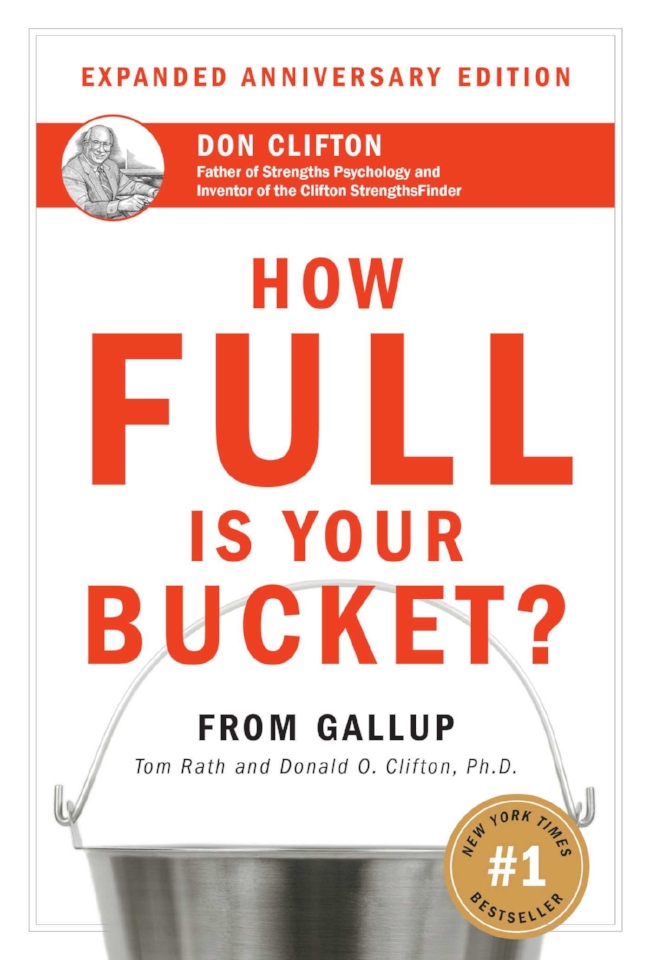BOOK FACTS
- Title: “How Full Is Your Bucket? Positive Strategies for Work and Life”
- Author: Tom Rath and Donald Clifton, Ph.D.
- Publisher: Gallup Press, New York, NY
- Copyright: 2004
- No. of Pages: 127
- No. of Chapters: 6
RATING (5 IS A MUST READ – 1 IS LOW INTEREST IN READING)
Readability: 5
Maintains Attention: 4
Applicability of Information: 5
REVIEW
What would you do if you knew you only had a few months to live? When Don Clifton found out
he had terminal cancer, he decided that he wanted to write one more book, and “How Full Is Your Bucket” was the result. He wrote it with the assistance of his grandson, Tom Rath, who saw Don as his mentor, teacher, role model and friend. Of course, Tom was not the only person to think highly of his grandfather. The American Psychological Association has cited Don Clifton as the Grandfather of Positive Psychology and the Father of Strengths Psychology. This is because Don’s entire career as a psychologist focused not on what is wrong with people, but what is right with them.
The entire book is built around the Theory of the Dipper and the Bucket. The idea is that each
person has an invisible bucket and dipper. Our bucket is constantly being filled or emptied,
depending upon what other people say or do to us. Positive words and actions add to our bucket, while negative, hurtful words and actions empties our bucket. We feel great when our bucket is full and lousy when our bucket is empty.
On the flip side, whenever we say and do to others fills or empties their buckets, as well. In fact,
there is an interesting reciprocity in action because whenever we fill another person’s bucket, our own fills up, too. And whenever we empty another person’s bucket, our own empties out, too. We either enrich or diminish ourselves by how we interact with others.
This Bucket concept is reminiscent of Stephen Covey’s Emotional Bank Account, which is found in his book, The 7 Habits of Highly Effective People, published in 1989. The Emotional Bank Account is a metaphor for the level of trust that exists in relationships. Like a bank account, every interaction with someone else results in either withdrawals or deposits into our emotional bank accounts. Positive words or actions make deposits into the bank account, resulting in more trust, and negative words or actions make withdrawals, resulting in less trust.
Although filled with research statistics, the Bucket concept is simplistic. In fact, the research
findings seemed more interesting and sophisticated than the Theory of the Dipper and the Bucket itself. However, it is easy to see how a simple idea like this could be taught and applied easily within organizations.
SUMMARY OF MAIN POINTS
The information presented in this book is not broken down into steps or stages. Rather, the basic
model of filling or dipping from buckets is applied to various work and life related issues, with
research from the Gallup Organization research data and millions of interviews to support their
claims:
Productivity: Regular recognition and praise in the workplace increases productivity,
engagement, loyalty and satisfaction, and safety ratings on the job.
Customer Service: Workers who are drained by excessive bucket dipping (negativity) on the
job have lower customer satisfaction ratings than those who do not.
Health: When employees are working with a boss they dislike, they have significantly higher
blood pressure (boss-induced hypertension). Recent studies also show that negative emotions
might even shorten your life span. Increasing positive emotions could lengthen life span by 10
years.
Education: Our culture is one in which parents’ and teachers’ first and primary focus is on
students’ bad grades rather than the good ones. It is a weakness based approach that follows us
throughout our lives.
The Magic Ratio: We experience a total of 20,000 individual moments every day, each lasting
a few seconds. Positive Psychology experts are finding that the ratio of positive to negative
interactions in those moments must be 5 to 1 of positive to negative in order for marriages to
increase the likelihood of success. (Researchers have predicted divorce rates among subject
couples with a 94% accuracy based on this ratio.) This ratio can be generalized to friendships,
other family and work relationships, as well.
Bucket Reserves: If you associate with people who are regularly adding drops into your bucket,
a reserve is built up that can sustain you through tougher times.
CALL TO ACTION
The following strategies are recommended by the authors of this book to increase positive emotions.
In the workplace, these can be seen as a set of management and leadership tools to increase
employee engagement and productivity:
1. Prevent Bucket Dipping: Focus on your own interactions with people in your lives, particularly at work, and catch yourself in the act of bucket dipping…and then stop it. By being aware of your own behavior, you can curtail your own bucket dipping tendencies. Then, take the next step and try to encourage similar changes among others around you. You will help serve as an example to them.
2. Shine a Light on What is Right: Take the opportunity to focus on what is right rather than what is wrong. That doesn’t mean you don’t address poor performance or behavior, but it shouldn’t be the first thing you focus on. Every interaction gives us the chance to focus on what is right and to fill another person’s bucket.
3. Make Best Friends: Research has shown that people with a best friend at work have higher customer satisfaction ratings, higher productivity, and better safety records. As a leader in an organization, you can encourage employees to become friends, setting up social events and encouraging fun.
4. Give Unexpectedly: A recent Gallup poll indicates that the vast majority of people prefer gifts that are unexpected. It fills our buckets just a little bit more than receiving expected gifts. And these unexpected gifts don’t have to be tangible. They can be a demonstration of trust or a gift of responsibility.
5. Reverse the Golden Rule: Instead of “Do unto others as you would have them do unto you,” the Bucket theory turns it around to “Do unto others as they would have you do unto them.” This requires the extra effort of getting to know people personally so that the positive words,
behaviors or gifts are exactly what they would want, and not what you think they want.


